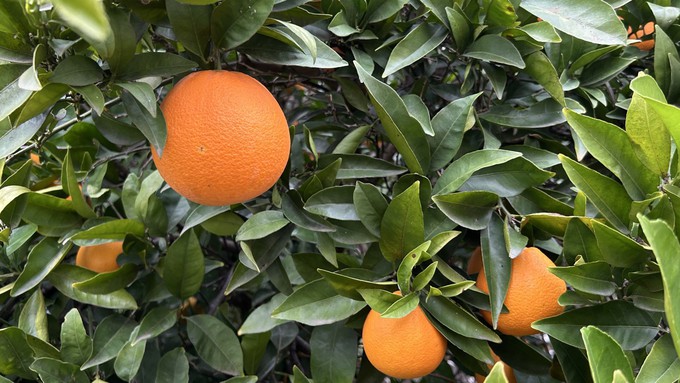
Taste-test the fruit -- every year can be slightly different

These Washington navel oranges are very close to ripe. Taste one if you're not sure -- but it's best not to pick them all at once. Kathy Morrison
In early December a few years ago, I arrived at my community garden and noticed that the little navel orange tree in the Garden of Eatin' area (available to all the gardeners) had been picked clean. Oh, no, I thought, those oranges weren't ripe yet.
Sure enough, one of the other gardeners mentioned that he had tried one. "It was sour!" he said with surprise. Yes, the fruit had been orange in color, but it was too soon -- the sweetness that develops with colder weather hadn't happened yet. Another (small) crop lost to inexperience with the quirks of citrus trees.
Growing citrus can be, as I noted once, like keeping a pet cat: You love it, but rarely understand it. The trees follow their own calendar, which is nothing like the timelines for cherries or apples. The master gardener help desk often receives questions about citrus trees or fruit from perplexed homeowners.
Some citrus can be used at various stages of ripeness -- limes being a good example -- but navel oranges need to be fully ripe to be enjoyed.
So how to tell? There are clues: They should have full color, be heavy for their size, and be firm but not rock-hard -- they should give just slightly when squeezed.
But by far the best test is tasting one, or two, really: One from each side of a full-size tree. (One from a container tree should be plenty.) If it doesn't taste ripe, wait a week and try again.
One of my neighbors traditionally picks all her oranges on Christmas Day. That to me is a gamble -- and unless she gives most of the fruit away, creates other problems. Storage, for one. (If you must: Keep them in boxes in a cold garage, in one layer. Or juice them and freeze the juice.)
Also, citrus does not ripen off the tree, so whatever stage that fruit was in will be the stage it stays in, until it's eaten or rots.
"Storing" the fruit on the tree is generally the best move, with one caveat: If a hard frost is expected, pick all the ripe fruit before the cold hits. Make sure the tree is well-watered, too. Orange trees can survive temperatures down to 21 degrees, but the fruit may be damaged below 27 degrees or so, according to the UC Cooperative Extension experts. (The Sacramento master gardeners' Garden Note 127, "Growing Citrus in Sacramento," has a wealth of information. It can be found via "The Home Orchard" page on the master gardeners' website; it's the first link under Master Gardener publications and videos.)
"Citrus sensitivity to cold also depends on how long it stays cold, whether the trees are exposed or in a protected area, whether the trees are in a low area where cold air collects, and how old the trees are," the information also explains.
So become familiar with the timeline for your own tree or trees, noting the changes in the weather as winter continues. And enjoy those gorgeous oranges you've been growing all these months!
Comments
0 comments have been posted.Sacramento Digs Gardening to your inbox.
Food in My Back Yard Series
May 6: Maintain soil moisture with mulch for garden success
April 29: What's (already) wrong with my tomato plants?
April 22: Should you stock up on fertilizer? (Yes!)
April 15: Grow culinary herbs in containers
April 8: When to plant summer vegetables
April 1: Don't be fooled by these garden myths
March 25: Fertilizer tips: How to 'feed' your vegetables for healthy growth
March 18: Time to give vegetable seedlings some more space
March 11: Ways to win the fight against weeds
March 4: Potatoes from the garden
Feb. 25: Plant a fruit tree now -- for later
Feb. 18: How to squeeze more food into less space
Feb. 11: When to plant? Consider staggering your transplants
Feb. 4: Starting in seed starting
Sites We Like
Garden Checklist for week of May 11
Make the most of the lower temperatures early in the week. We’ll be back in the 80s by Thursday.
* Plant, plant, plant! It’s prime planting season in the Sacramento area. Time to set out those tomato transplants along with peppers and eggplants. Pinch off any flowers on new transplants to make them concentrate on establishing roots instead of setting premature fruit.
* Direct-seed melons, cucumbers, summer squash, corn, radishes, pumpkins and annual herbs such as basil.
* Harvest cabbage, lettuce, peas and green onions.
* In the flower garden, direct-seed sunflowers, cosmos, salvia, zinnias, marigolds, celosia and asters. (You also can transplant seedlings for many of the same flowers.)
* Plant dahlia tubers.
* Transplant petunias, marigolds and perennial flowers such as astilbe, columbine, coneflowers, coreopsis, dahlias, rudbeckia and verbena.
* Keep an eye out for slugs, snails, earwigs and aphids that want to dine on tender new growth.
* Feed summer bloomers with a balanced fertilizer.
* For continued bloom, cut off spent flowers on roses as well as other flowering plants.
* Add mulch to the garden to maintain moisture. Mulch also cuts down on weeds. But don’t let it mound around the stems or trunks of trees or shrubs. Leave about a 6-inch-to-1-foot circle to avoid crown rot or other problems.
* Remember to weed! Pull those nasties before they set seed.
* Water early in the day and keep seedlings evenly moist.